Reading Time: 10 minutes
Perch fishing holds a special place in the hearts of anglers around the world. Whether you’re casting a line for the vibrant Yellow Perch in North America or pursuing the feisty European Perch across the waters of Eurasia, these fish offer a rewarding challenge to fishermen of all skill levels. Known for their distinctive stripes and flavor, Perch are not just a joy to catch but also a treat on the dinner table.
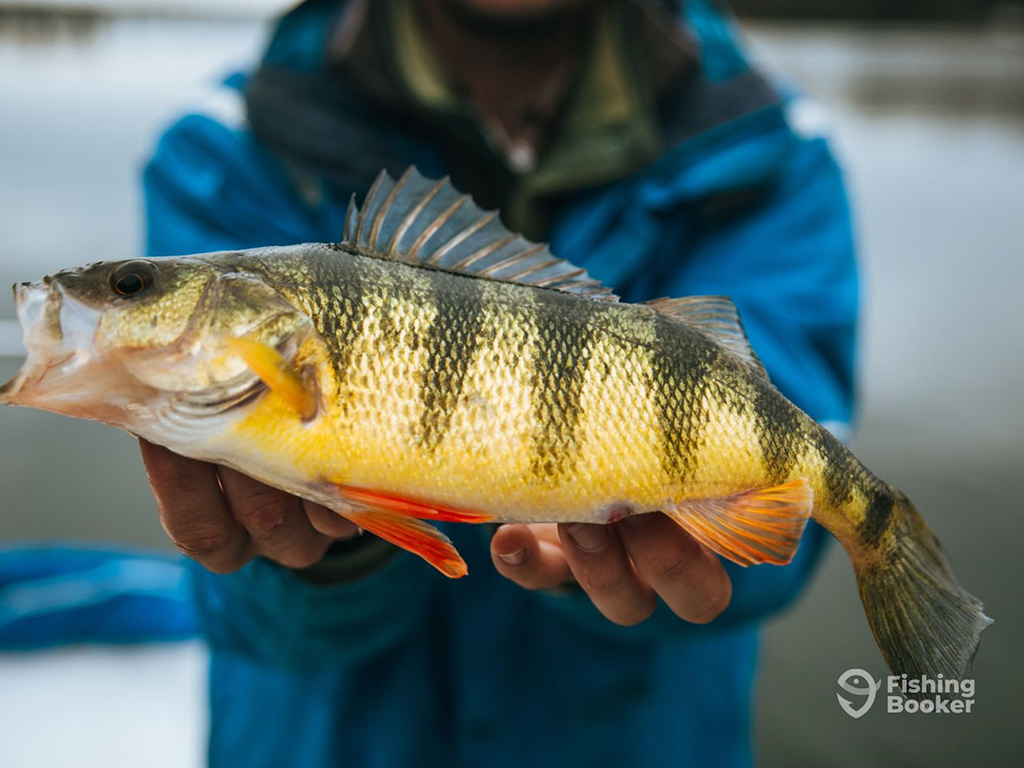
Photo courtesy of Bay Bound Guide Service
Thriving in a variety of aquatic environments, from deep, cool lakes to slow-moving rivers, Perch are accessible and abundant, making them a popular target for both novice and seasoned anglers. Their tendency to school makes them an exciting species, promising not just a solitary catch but potentially a bountiful haul.
Whether you’re looking forward to a serene day by a lake or an adventurous excursion on the ice, Perch fishing offers a uniquely rewarding experience. Grab your tackle box, and let’s embark on this journey to master the art of catching Perch.
Understanding Perch
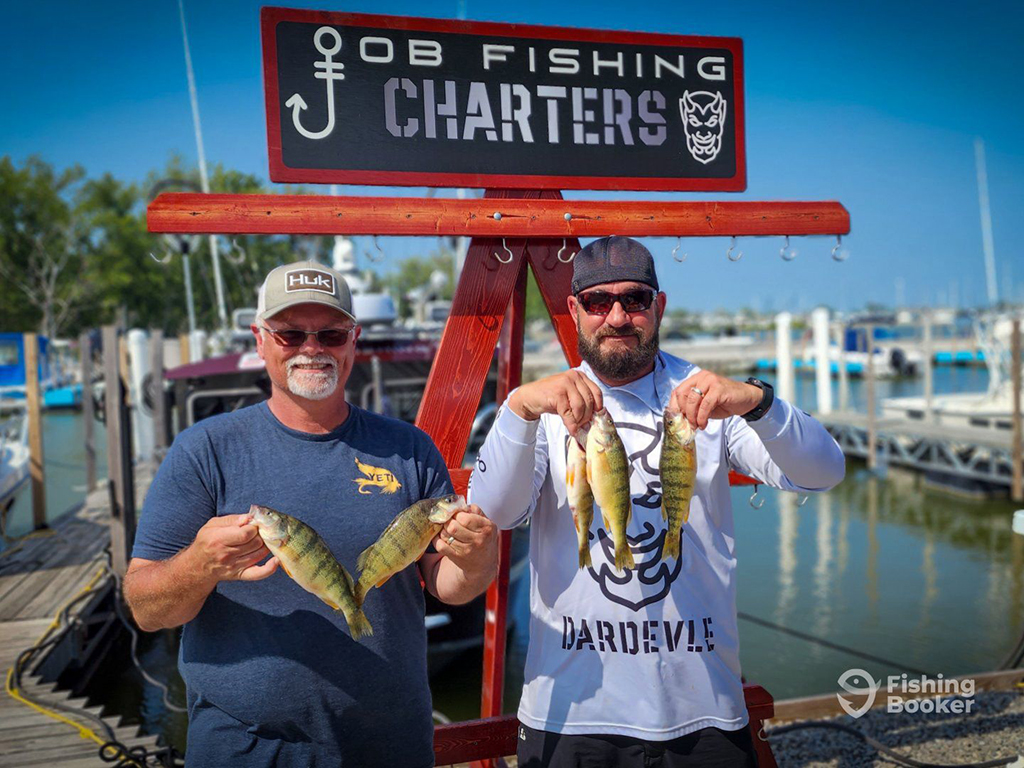
Photo courtesy of JOB Fishing Charters – Dardevle
The first step in learning how to land Perch is understanding them. I’m talking about knowing their habitat, activity, feeding patterns, and general tendencies. With their distinct patterns and lively nature, Perch are more than just a common catch. They’re a fascinating species to understand for any angler. Gaining an insight into their behavior and habitat is key to mastering Perch fishing.
Habitat Preferences
Perch are remarkably adaptable and can thrive in a variety of bodies of water. The Yellow Perch, a staple in North American waters, is often found in freshwater lakes, ponds, and slow-flowing rivers. They favor areas with clean, clear water and abundant aquatic vegetation, which offers shelter and ample feeding opportunities.
European Perch share similar habitats, commonly inhabiting the lakes and rivers of Europe and parts of Asia. They’re known to prefer areas with moderate depths, where the water temperature is cooler and more to their liking.
Schooling Behavior
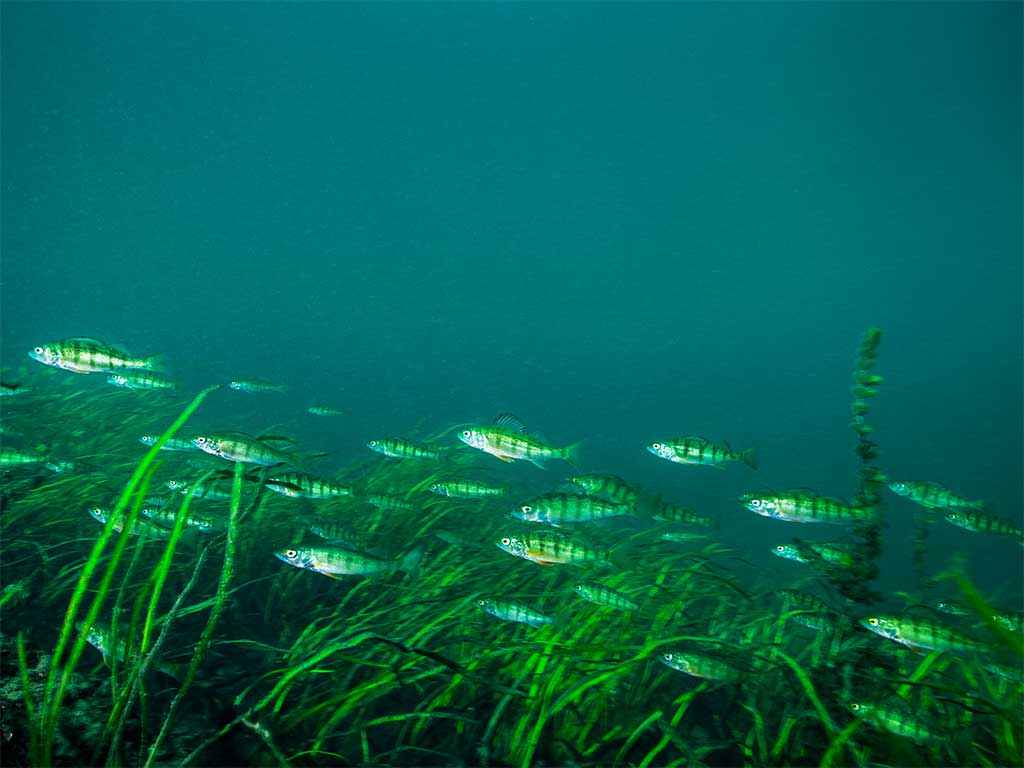
One of the most distinctive traits of Perch is their schooling behavior. Perch tend to group together, especially during feeding times. This trait is particularly beneficial for anglers, as finding one Perch often indicates the presence of more. The size of the school can vary. However, it’s not uncommon to find large numbers congregating in areas abundant in food.
Feeding Habits
Perch are primarily daytime feeders, with peak activity around dawn and dusk. Their diet mainly consists of smaller fish, insects, larvae, and crustaceans. Young Perch tend to feed on plankton and gradually shift to larger prey as they grow. This varied diet makes them an interesting species to target, as they’ll take a wide range of baits.
Seasonal Patterns
Understanding the seasonal movements of Perch is crucial to come out on top against them. In spring, Perch migrate to shallower waters to spawn, making them more accessible to shore anglers. Post-spawn, they move to deeper waters to recuperate and feed.
Summer sees them in deeper, cooler parts of the water, while in the fall, they often return to shallower areas. Perch are a popular target when ice fishing in winter, as they remain active under the frozen water.
Size and Growth
Perch are relatively small but can grow to impressive sizes. Yellow Perch average around 4–10 inches and the European Perch slightly larger. Their growth rate is influenced by factors like food availability and water temperature.
How to Catch Perch with Live Bait
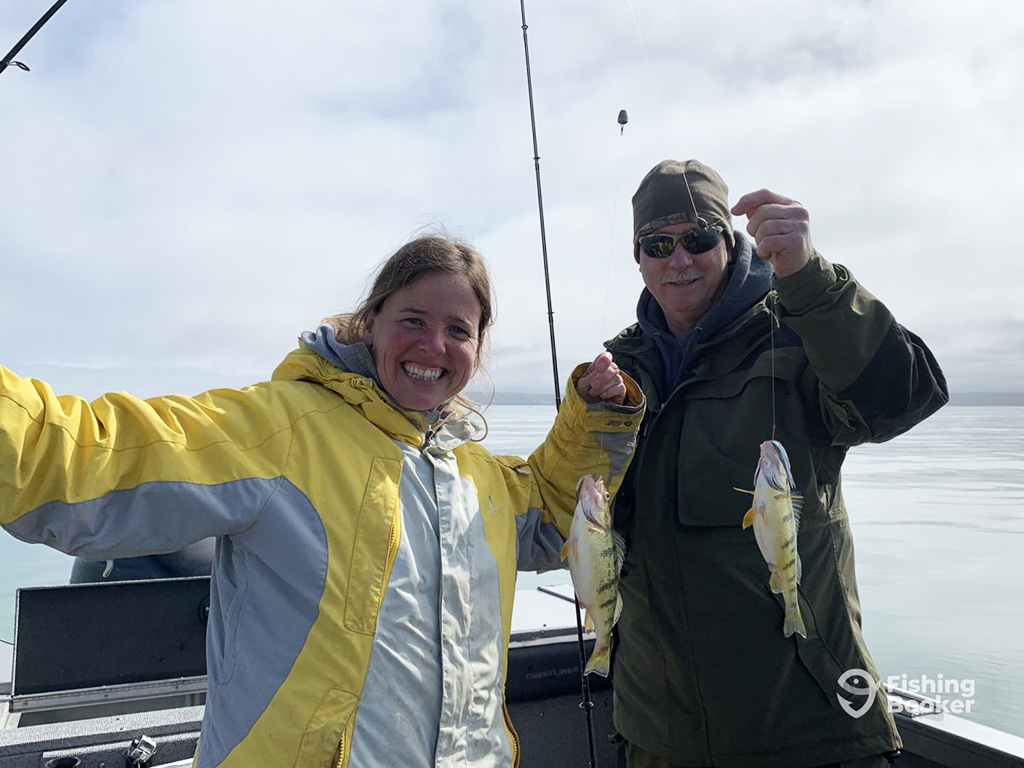
Photo courtesy of Day Five Sportfishing Charters
It goes without saying that bait plays another important role in determining how successful you’ll be when fishing for Perch. They’re fans of both live and artificials, but let’s focus on the former for now…
Worms
The natural movement of worms, particularly nightcrawlers and red worms, is a reliable trigger for Perch, who often feed on small invertebrates. When baiting, thread the worm onto the hook to allow for some natural wriggling motion. This presentation is most effective in the early morning or late evening, as Perch will actively be feeding in shallower waters during these times, especially in spring and fall.
Minnows
Small minnows are a realistic representation of a Perch’s natural prey, especially effective for larger Perch in deeper waters. Hooking the minnow through the lips or back allows it to swim naturally, mimicking an injured fish. This method is particularly productive in summer when Perch are more aggressive and in winter under the ice, where minnows are a primary food source.
Insect larvae
Using maggots, waxworms, or mealworms can be a game-changer, especially when ice fishing in colder months. Perch slow down in cold water, and these larvae, being part of their natural diet, are an easy target. Hook them gently to maintain natural movement, and use them in a setup that allows the bait to remain just off the bottom.
How to Catch Perch with Artificial Lures
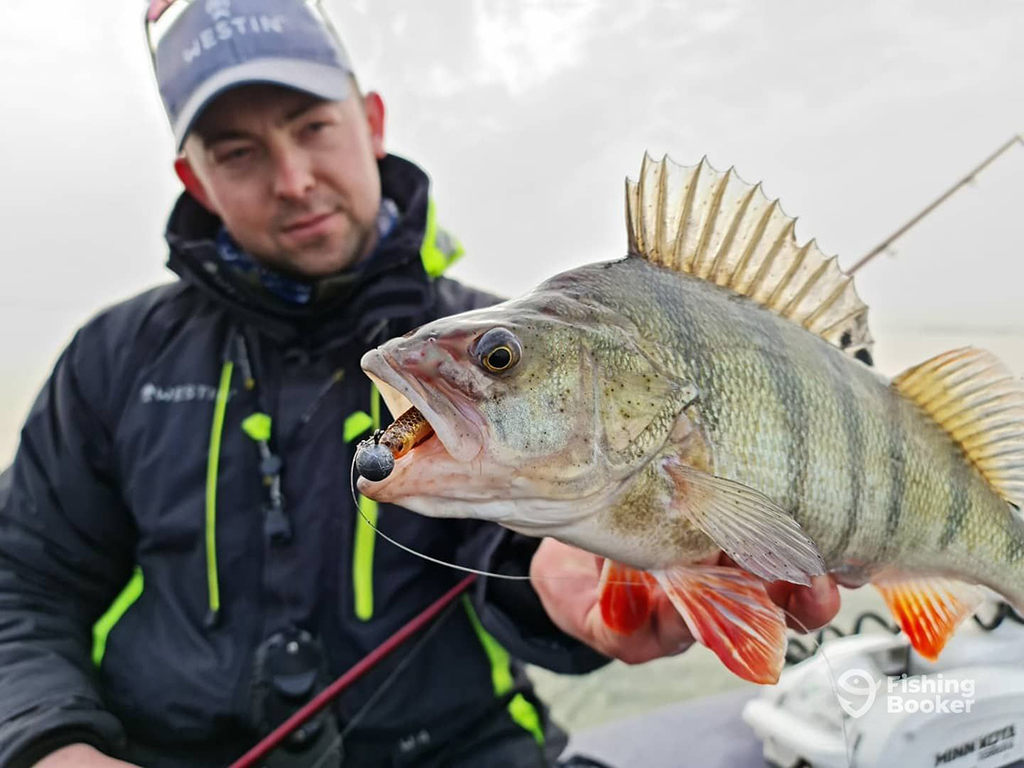
Photo courtesy of JEvisgids – Big Perch Fishing
Small Spinners
These lures work well due to their ability to mimic the flash and vibration of small fish or insects – a primary food source for Perch. Their effectiveness is enhanced in clear water where Perch rely more on sight. The morning and evening light conditions create a glare on the spinner blades, making them more noticeable and attractive to Perch.
Jigs
Soft plastic jigs are successful because they imitate the movement of worms and aquatic larvae. Jigging them off the bottom simulates a bug or worm emerging from the sediment, a common feeding cue for Perch. Experimenting with jigging speed and amplitude can mimic various prey behaviors, making them effective in different water conditions and times of the year.
Crankbaits
Mini crankbaits are most effective in the mornings and evenings during summer because this is when smaller bait fish are most active, and Perch are hunting them. The low light conditions of dawn and dusk make Perch less cautious and more likely to strike at bait fish imitations. Crankbaits mimic the erratic movement of these small fish, making them irresistible to hunting Perch.
Techniques for Perch Fishing in Open Water
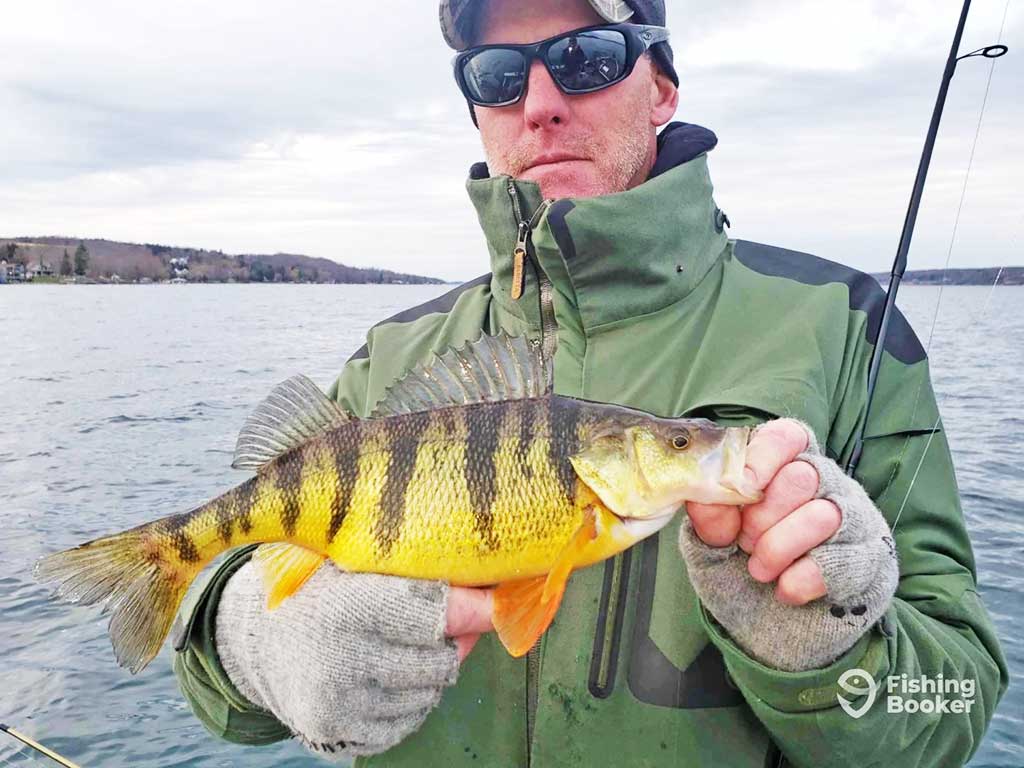
Photo courtesy of Upstate Guide Service
When it comes to successful open-water Perch fishing, the technique you choose can be just as important as your bait selection. Perch are known for their specific habits and preferences, so understanding and adapting your approach to these nuances is key. Let’s delve into some of the most effective techniques for catching Perch in open waters.
Still Fishing
A favorite among both shore and boat anglers, still fishing is a method that requires patience but can yield impressive results. For shore anglers, locations with access to deep waters, such as piers or rocky outcrops, are ideal.
Here, submerged structures like fallen trees or weed beds are hotspots, as Perch often congregate around these natural shelters. Using a float to control the depth of your bait is crucial, as Perch tend to feed at different depths depending on the time of day and water conditions. Morning and evening are typically the most productive times, with Perch venturing into shallower areas to feed.
For those fishing from a boat, employing a fish finder can be invaluable in locating schools or identifying underwater structures where Perch may be hiding. Anchoring near these spots and using a bottom rig with live bait, such as minnows or worms, can be very effective. The key is to keep the bait just above the bottom, where Perch are likely to be looking for their next meal.
Drifting
In larger bodies of water, drifting allows you to cover more ground and locate schools of Perch. This method is particularly effective when the Perch are scattered. By allowing the boat to drift naturally with the wind or current, you can present your bait across various depths and terrains.
Light jigs or live bait rigs are popular choices here, offering a natural presentation that’s likely to attract Perch. Sensitivity to the bite is crucial here, as Perch can often be gentle feeders.
Vertical Jigging
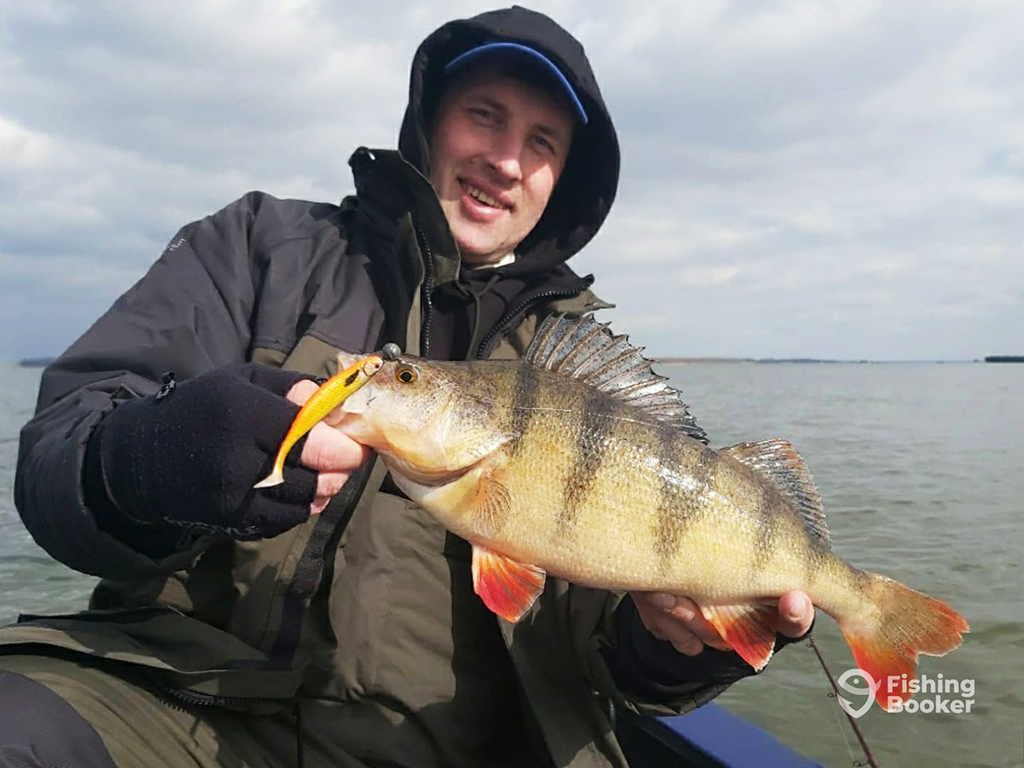
Photo courtesy of JEvisgids – Big Perch Fishing
This technique shines in deeper water environments or when Perch are suspended at specific depths. Dropping a jig to the desired depth and then performing a series of rhythmic upward and downward motions mimics the movement of prey, which is often too tempting for Perch to ignore.
In warmer waters, a quicker jigging motion can provoke an aggressive response from active Perch. Conversely, in cooler temperatures, a slower and more measured jigging action can be more enticing.
Casting and Retrieving
Using small spinners, spoons, or crankbaits can also be effective, especially in areas where Perch are known to actively hunt. The technique involves casting the lure near potential Perch locations, like weed lines or submerged logs, and then retrieving it in a manner that mimics fleeing prey.
Varying the speed and pattern of your retrieval can help in finding the right combination that triggers a bite. The choice of lure should be reflective of the Perch’s natural prey in the area, with small, bright lures often being effective. However, in clearer waters, opting for lures that mimic the natural colors of local bait fish can yield better results.
Each of these techniques offers a unique way to engage with Perch fishing, bringing its own set of challenges and rewards. The most successful anglers are those who not only understand these techniques but can also adapt them to the conditions at hand, responding to the Perch’s behavior and the environment.
Finding the Perfect Spot to Catch Perch
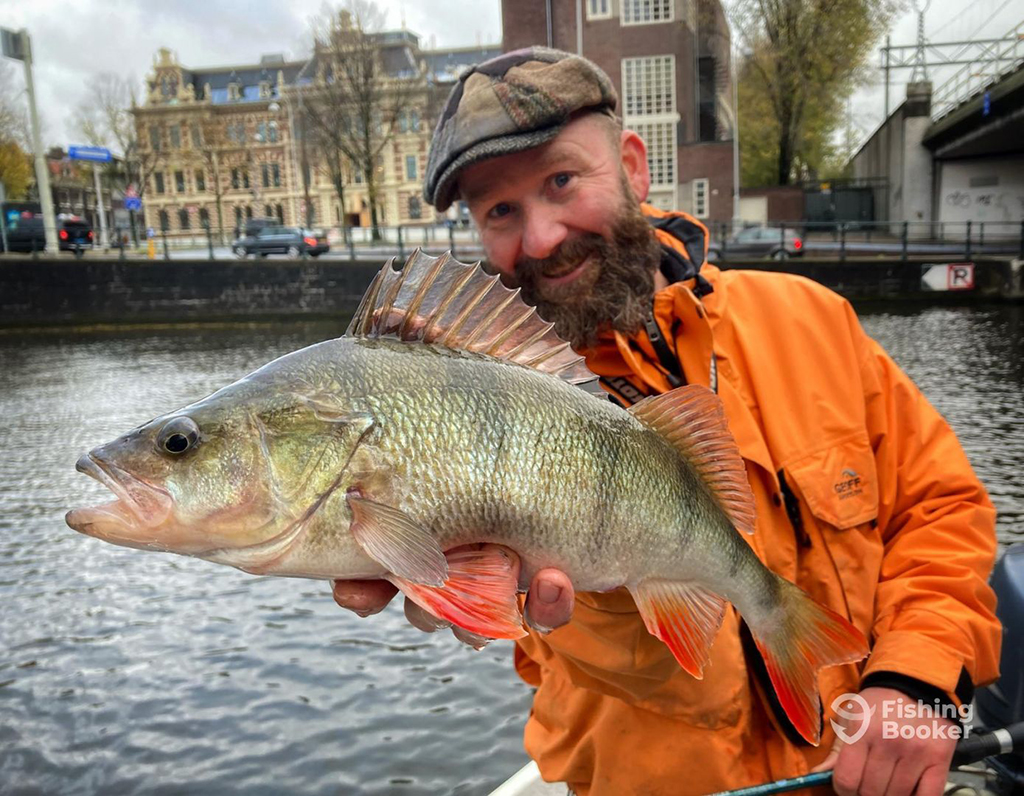
Photo courtesy of UFX Fishing Guide Amsterdam
Perch are adaptable fish but they have a particular affinity for areas with abundant underwater structures. These structures, which include weed beds, submerged logs, rock piles, and man-made features like docks and piers, provide shelter and an abundant food source for Perch.
In lakes and ponds, look for areas where there’s a change in the underwater topography – such as points, drop-offs, and submerged ridges. These areas often serve as highways for Perch, especially when they move between feeding and spawning areas.
In rivers and streams, Perch tend to gather where there’s a break in the current, such as near bends, confluences, or areas with submerged objects that disrupt the water flow. These spots allow Perch to conserve energy while still having access to passing food. Additionally, areas where tributaries meet larger bodies of water can be productive, as these junctions create natural gathering points for various fish species, including Perch.
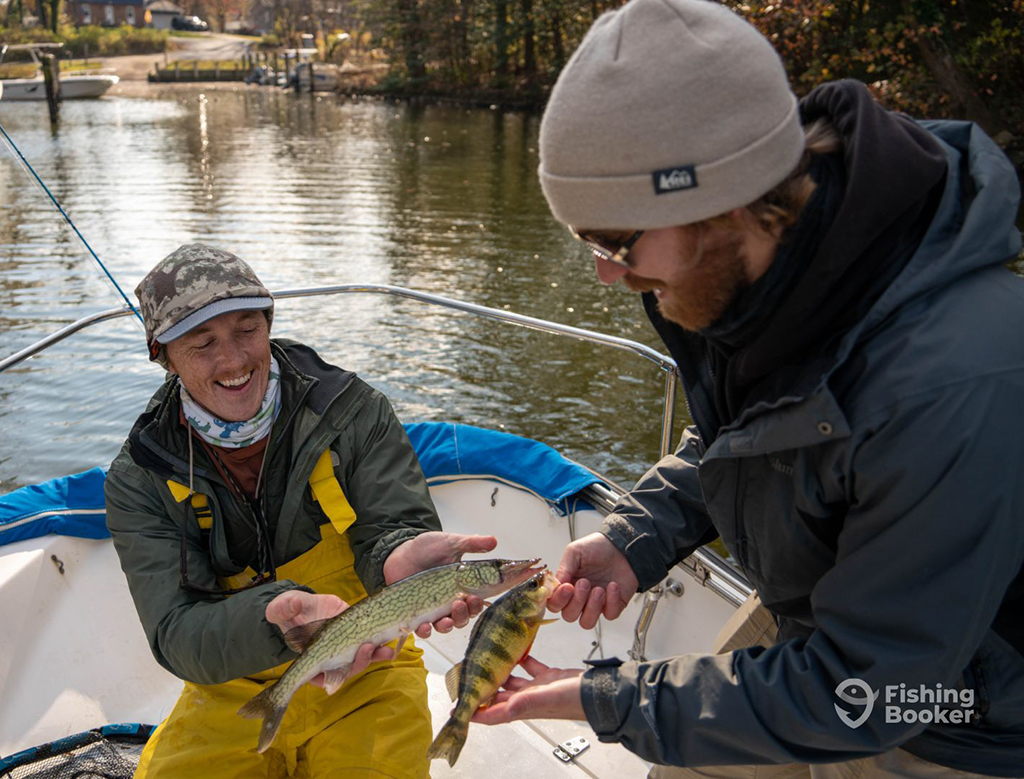
Photo courtesy of Bay Bound Guide Service
Seasonal patterns also play a significant role in determining the best Perch fishing spots. During the spawning season in spring, Perch move to shallower waters. This makes them more accessible, especially for shore anglers. Post-spawn, they tend to move into deeper, cooler waters as temperatures rise. During this time, boat fishing in deeper areas can be more productive. In the fall, Perch often return to shallower waters as they prepare for the winter, making them once again accessible to a wider range of fishing techniques.
Understanding the water conditions is also essential. In clear waters, Perch can be more spread out and may require a stealthier approach. In contrast, in murky or stained waters, they rely more on their sense of smell and vibration, making them likely to be closer to bait fish and more responsive to lures with strong scents or vibrations.
By combining knowledge of Perch behavior, water topography, seasonal patterns, and water conditions, anglers can identify promising spots for Perch fishing. Remember, Perch are dynamic creatures, and their location can change based on a variety of factors. Flexibility and a willingness to explore different areas and depths can lead to a more rewarding Perch fishing experience.
Tips and Tricks for Successful Perch Fishing
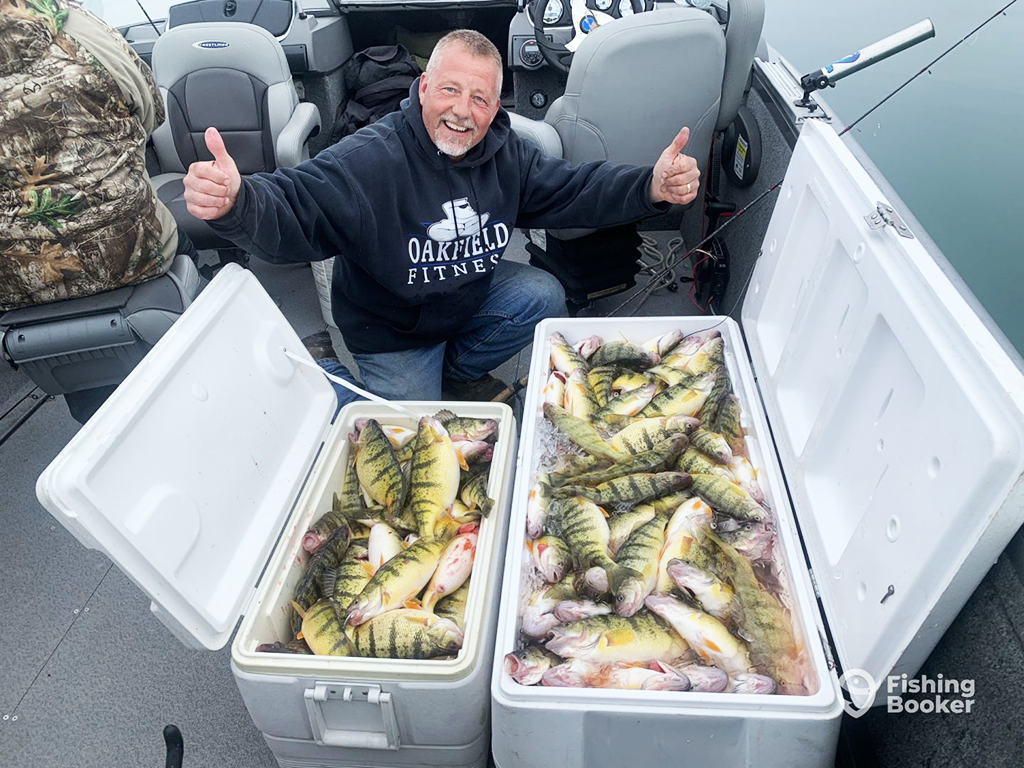
Photo courtesy of Day Five Sportfishing Charters
Successful Perch fishing often involves more than just the right spot or the perfect bait – it’s the culmination of various tips and tricks that seasoned anglers gather over time. Here are some additional insights to enhance your Perch fishing experience:
Timing is Key
Perch are most active during specific times of the day. Early morning and late evening are generally the best times to fish for Perch, as they’re more likely to feed actively during these periods. Additionally, Perch tend to feed more aggressively just before a weather change, such as an approaching storm or a sudden temperature shift.
Be Observant of the Environment
Perch fishing can often be improved by closely observing environmental cues. Look for signs of feeding fish, such as birds diving into the water, as this can indicate the presence of bait fish that Perch feed on. Also, pay attention to the wind direction. Wind can push bait fish toward certain areas of the lake or river, with Perch likely following closely behind.
Use Light Tackle
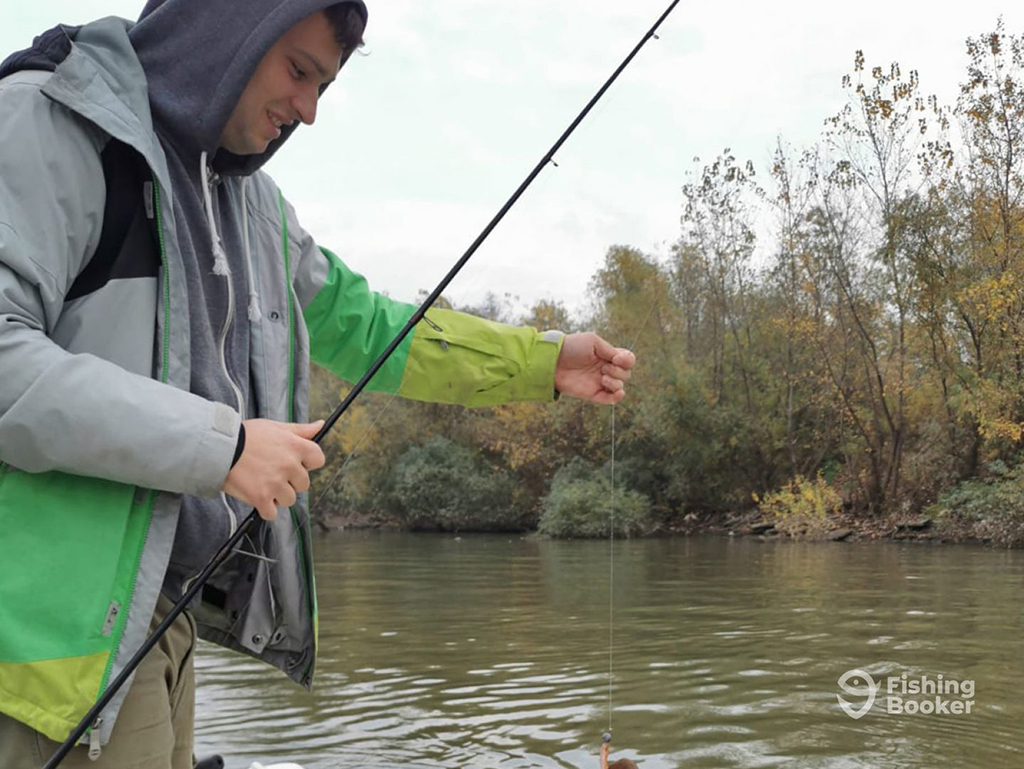
Photo courtesy of Belgrade Fishing Tour
Perch, especially smaller ones, have a soft bite. Using light tackle can help in detecting these subtle bites more effectively. A light line, small hooks, and a sensitive rod can make all the difference in feeling a Perch take the bait and successfully setting the hook.
Experiment with Bait and Lures
Don’t hesitate to switch between different types of bait and lures. Sometimes, Perch might prefer live bait over artificial lures or vice versa, depending on the day or the specific water body. Having a variety of bait options at your disposal can be crucial, especially on days when Perch are more finicky.
Keep it Moving
Perch are attracted to movement. When using lures, vary your retrieval speeds and patterns. A stop-and-go retrieval can sometimes be more effective than a steady retrieve. Similarly, when using live bait, occasionally twitching your rod can give the bait a more dynamic and enticing movement.
Depth Matters
You’ll often find Perch at specific depths, depending on the time of year and water temperature. Don’t hesitate to experiment with fishing at different depths until you find where the Perch are actively feeding. This can involve adjusting the length of the line below your float or changing the weight on your line to reach different depths.
Perch Fishing: Fun for All – If You Know How
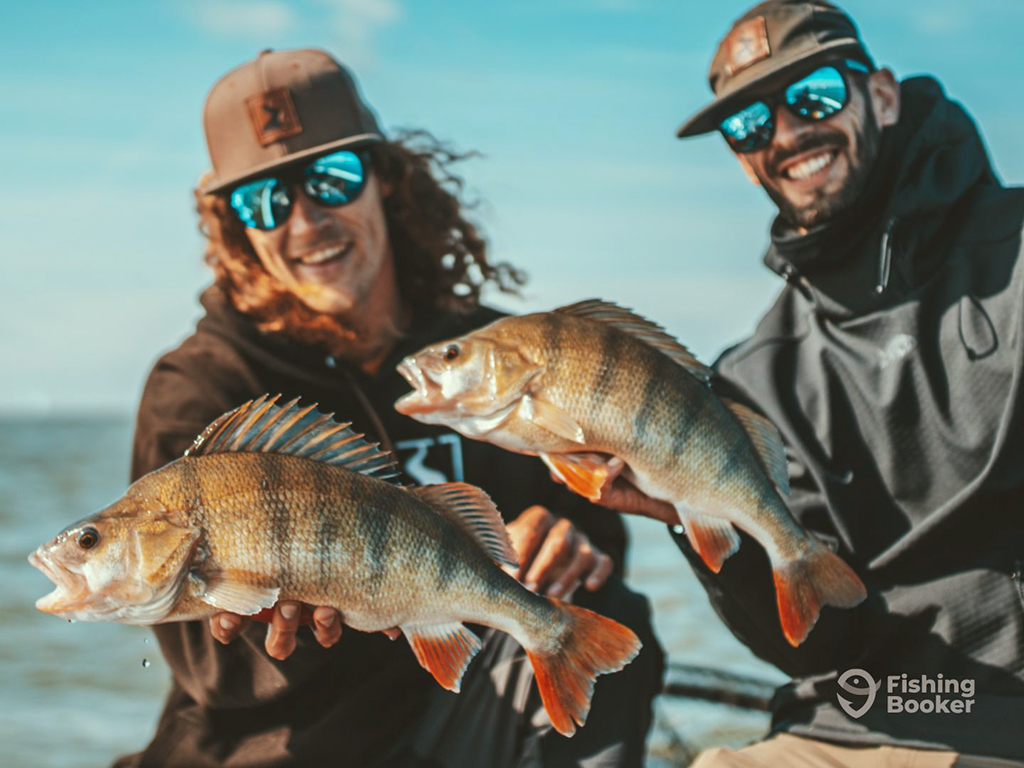
Photo courtesy of Ijsselmeer / Ketelmeer fishing guide
It’s clear that fishing for this popular species combines skill, knowledge, and a bit of angling intuition. Whether you’re casting off from a serene lakeshore at dawn, drifting gently in a boat, or standing on a bustling pier, the pursuit of Perch offers a delightful challenge suited to anglers of all levels.
Remember, successful Perch fishing isn’t just about the size or number of fish caught. It’s about understanding and connecting with the environment, adapting to the behavior of the Perch, and enjoying the overall experience. Each outing is an opportunity to refine your techniques, experiment with different baits and lures, and observe the subtle nuances that make fishing such a rich and rewarding sport.
As you embark on your next Perch adventure, remember to respect the habitats of these fish and practice sustainable fishing. By doing so, you ensure that the joy of Perch fishing can be shared and enjoyed for generations to come!
Are you an avid Perch angler? Have any tips and tricks of your own to share? We’d love to here from you in the comments section below!
The post How to Go Perch Fishing: An Angler’s Guide appeared first on FishingBooker Blog.
https://fishingbooker.com/blog/perch-fishing/
 CampingSurvivalistHuntingFishingExploringHikingPrivacy PolicyTerms And Conditions
CampingSurvivalistHuntingFishingExploringHikingPrivacy PolicyTerms And Conditions
